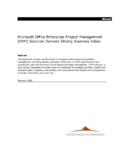Transcription of Measuring logistics costs and performance - …
1 Measuring logistics costsand performanceLogistics and the bottom line 83 logistics and shareholder value 88 logistics cost analysis 95 The concept of total cost analysis 96 Principles of logistics costing 99 Customer profitability analysis 103 Direct product profitability 109 Cost drivers and activity-based costing 11181 Chapter 12/11/04 12:04 pm Page 81 This chapter:Outlines the many ways in which logistics manage-ment can impact on overall return on investment and,ultimately, shareholder value . Explains the rationale behind total cost analysis, a sys-tematic logistics -oriented cost accounting system andthe principal requirements for an effective logisticscosting system.
2 Emphasizes the importance of customer profitabilityanalysis based upon an understanding of the cost-to-serve . Introduces the concept of direct product profitabilityand underlines the need to understand the customers logistics costs . Highlights the need to identify the cost drivers in thelogistics pipeline and to replace traditional forms ofcost allocation with more appropriate AND SUPPLY CHAIN 12/11/04 12:04 pm Page 82 The costs of satisfying customer demand can be significant and yet,surprisingly, they are not always fully understood by reason for this is that traditional accounting systems tend to befocused around understanding productcosts rather than logistics costs will vary by company and by industry, across theeconomy as a whole that total cost of logistics as a percentage of grossdomestic product is estimated to be close to 10 per cent in the US1andin other countries costs of similar magnitudes will be.
3 logistics activity does not just generate cost, it also gener-ates revenue through the provision of availability thus it is importantto understand the profit impact of logistics and supply chain the same time logistics activity requires resources in the form offixed capital and working capital and so there are financial issues to beconsidered when supply chain strategies are and the bottom lineToday s turbulent business environment has produced an ever greaterawareness amongst managers of the financial dimension of decisionmaking. The bottom line has become the driving force which, perhapserroneously, determines the direction of the company.
4 In some cases thishas led to a limiting, and potentially dangerous, focus on the short we find that investment in brands, in R&D and in capacity maywell be curtailed if there is no prospect of an immediate payback. Just as powerful an influence on decision making and managementhorizons is cash flow. Strong positive cash flow has become as much adesired goal of management as third financial dimension to decision making is resource utiliza-tion and specifically the use of fixed and working capital. The pressure inmost organizations is to improve the productivity of capital to makethe assets sweat.
5 In this regard it is usual to utilize the concept of returnon investment (ROI). Return on investment is the ratio between the netprofit and the capital that was employed to produce that profit, thus:3 Measuring logistics costs AND 12/11/04 12:04 pm Page 83 ProfitROI = Capital employedThis ratio can be further expanded:ProfitSalesROI = SalesCapital employedIt will be seen that ROI is the product of two ratios: the first,profit/sales, being commonly referred to as the margin and the second,sales/capital employed, termed capital turnover or asset turn.
6 Thus togain improvement on ROI one or other, or both, of these ratios mustincrease. Typically many companies will focus their main attention onthe margin in their attempt to drive up ROI, yet it can often be moreeffective to use the leverage of improved capital turnover to boost example, many successful retailers have long since recognized thatvery small net margins can lead to excellent ROI if the productivity ofcapital is high, limited inventory, high sales per square foot,premises that are leased rather than owned and so illustrates the opportunities that exist for boosting ROIthrough either achieving better margins or higher assets turns or iso-curve reflects the different ways the same ROI can beachieved through specific margin/asset turn combination.
7 The chal-lenge to logistics management is to find ways of moving the iso-curveto the AND SUPPLY CHAIN MANAGEMENT8420% ROI15% ROI10% ROIP rofitSales(Margin)SalesCap Emp(Asset turn)Fig. The impact of margin and asset turn on 12/11/04 12:04 pm Page 84 The ways in which logistics management can impact on ROI are many andvaried. Figure highlights the major elements determining ROI and thepotential for improvement through more effective logistics management. logistics and the balance sheetAs well as its impact on operating income (revenue less costs ) logistics canaffect the balance sheet of the business in a number of ways.
8 In today sfinancially-oriented business environment improving the shape of the bal-ance sheet through better use of resources has become a priority. Once again better logistics management has the power to transformperformance in this crucial area. Figure summarizes the major ele-ments of the balance sheet and links to each of the relevant logisticsmanagement examining each element of the balance sheet in turn it will beseen how logistics variables can influence its final logistics costs AND PERFORMANCE85 SalesrevenueCostsCashAccountsreceivable/ payableInventoryFixed assetsProfitCapitalemployedReturn oninvestmentCustomerservicePipelinemanag ementCash-to-cashcycle timeLogisticsefficiencyJust-in-timelogis ticsAssetdeploymentand utilizationFig.
9 logistics impact on 12/11/04 12:04 pm Page 85 Cash and receivablesThis component of current assets is crucial to the liquidity of the busi-ness. In recent years its importance has been recognized as morecompanies become squeezed for cash. It is not always recognized how-ever that logistics variables have a direct impact on this part of thebalance sheet. For example, the shorter the order cycle time, fromwhen the customer places the order to when the goods are delivered,the sooner the invoice can be issued. Likewise the order completionrate can affect the cash flow if the invoice is not issued until after thegoods are despatched.
10 One of the less obvious logistics variables affect-ing cash and receivables is invoice accuracy. If the customer finds thathis invoice is inaccurate he is unlikely to pay and the payment lead timewill be extended until the problem is per cent or more of a company s current assets will often be tiedup in inventory. logistics is concerned with all inventory within thebusiness from raw materials, subassembly or bought-in components,through work-in-progress to finished goods. The company s policies oninventory levels and stock locations will clearly influence the size of totalinventory.















